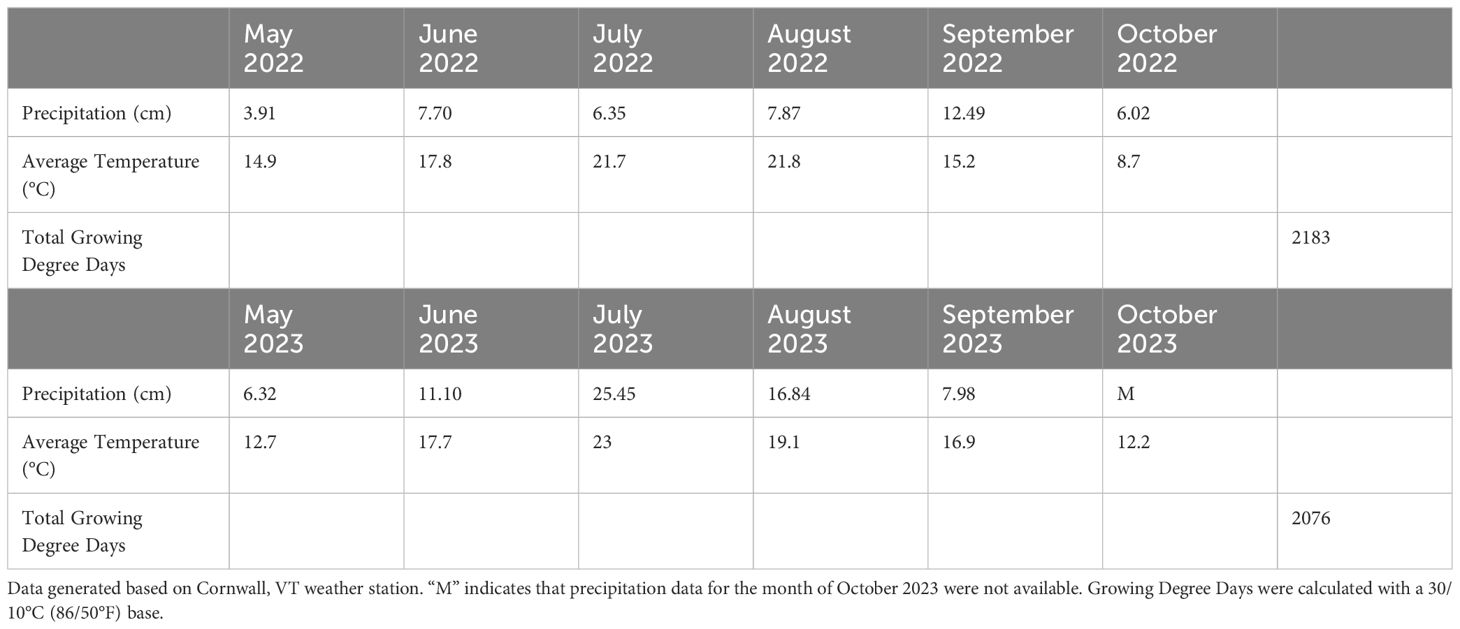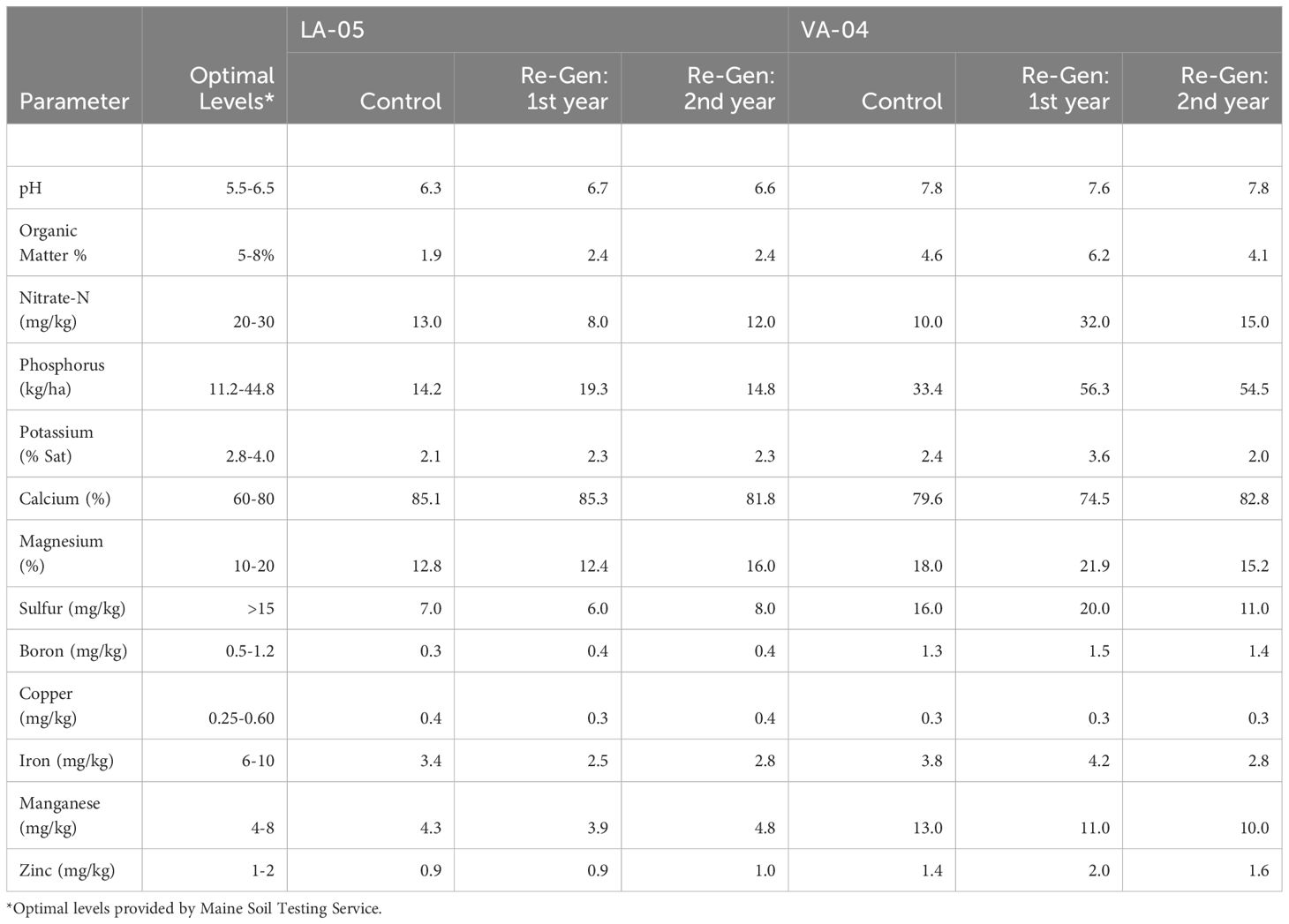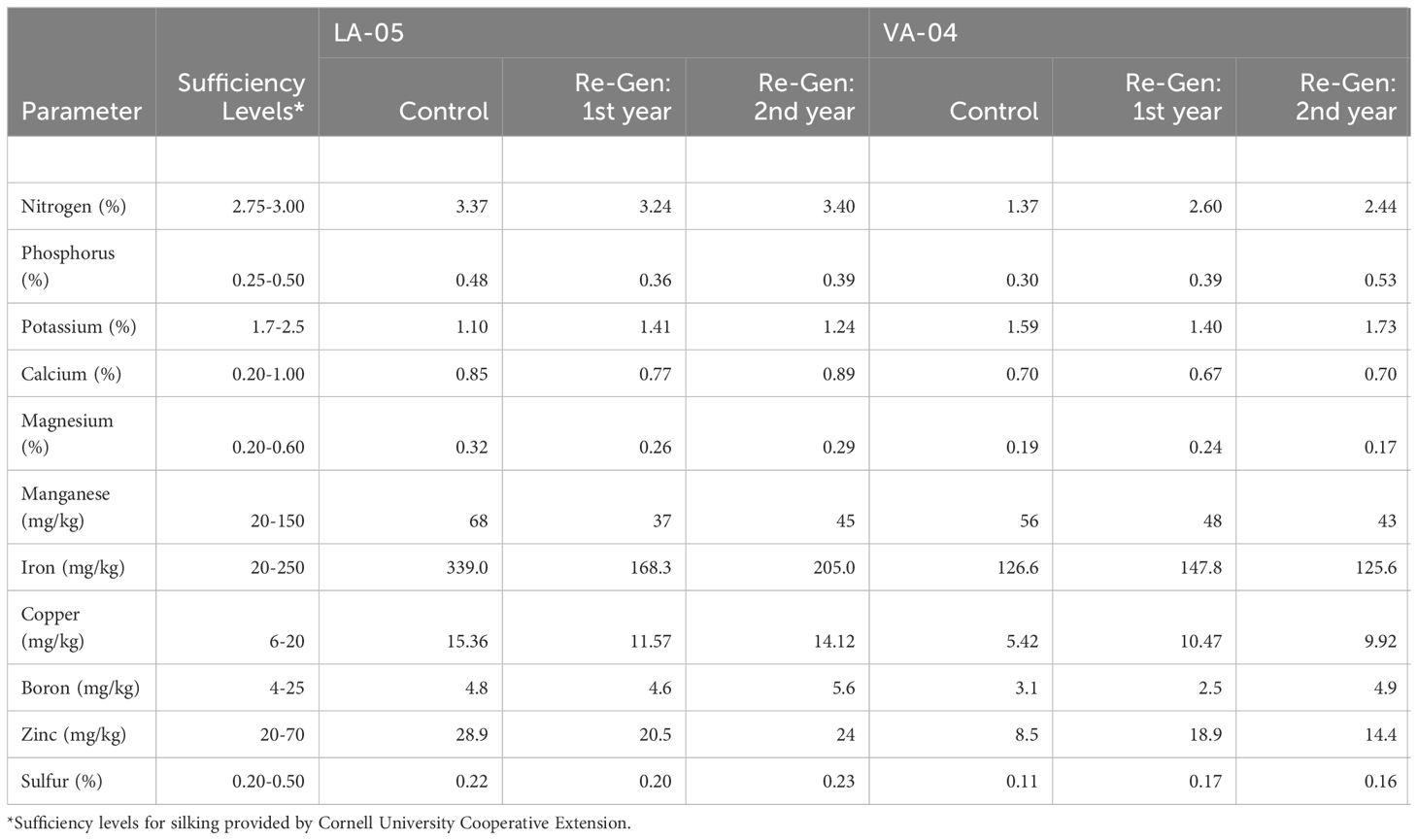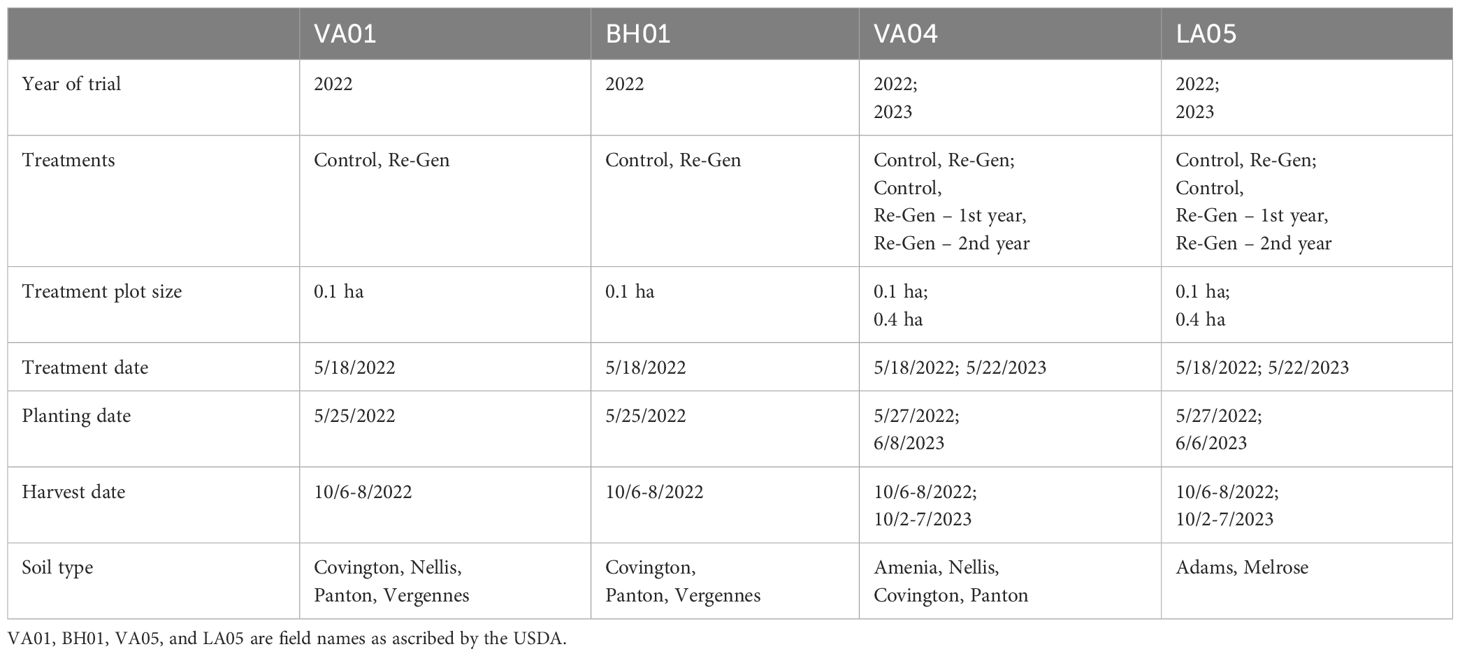- 1Willie’s AGRI-Culture Services LLC, Ryegate, VT, United States
- 2Research & Development, IMIO Technologies, Inc., Essex Junction, VT, United States
- 3Department of Agriculture Landscapes and Environment, University of Vermont, Burlington, VT, United States
Introduction: There is a need to rebuild soil health by implementing regenerative agricultural practices across cropping systems dependent on agrochemicals, such as in United States corn production. One increasingly utilized regenerative practice is the application of biostimulants, or microbial inoculants that can rebuild soil health and productivity. In this study, we describe results from a multi-year corn trial conducted to quantify the impact of Re-Gen, a biostimulant invented to recycle plant biomass and increase nutrient bioavailability in the soil.
Methods: Re-Gen was applied across four fields (VA01, BH01, VA04, and LA05) at a dairy cattle farm in Ferrisburgh, VT.
Results: Over the two consecutive years (2022-2023) of the trial, Re-Gen application on corn stover and cover crop residues increased ear corn yield by 24% and corn silage yield by 12.5-30%, depending on the field. Analysis of soil nutrients and plant tissues showed increased nutrients, particularly in field LA-05. Multi-year Re-Gen application increased yield and generated additional economic value, indicating that the effects of Re-Gen do not diminish with multiple applications. The increased corn silage yield correlated to increased potential milk yield from cows fed silage grown in Re-Gen-treated fields. Further investigation into the mechanism suggests that increased phosphatase production Re-Gen could contribute to increased phosphorus bioavailability in the soil and uptake in the tissue, potentially increasing yields.
Discussion: These results highlight the potential for Re-Gen to foster regenerative agriculture processes on cropland and livestock farms while also increasing corn and milk yield and, therefore, revenue for corn farmers in the United States and for similar cropping systems worldwide.
1 Introduction
More than 389 million metric tons (15.1 billion bushels) of corn (Zea mays) for grain were produced in the United States in 2023 alone (USDA, 2023). To grow such large quantities of corn, the use of synthetic chemical inputs is often required, including fertilizers and pesticides. In Midwestern corn and soybean cropping systems, where more than 75% of all US corn is grown, nitrogen fertilizer is applied at an average rate of 135 kg N/ha/year, amounting to $15.8B spent on fertilizer in 2022 in the Midwestern US alone (Russell et al., 2009; USDA, 2023; USDA and US Agricultural Statistics Service, 2023). The dependency upon agrochemicals and other synthetic inputs has ultimately negatively impacted the environment and soil microbiome of the Midwest (Russell et al., 2009; Revillini et al., 2019; Potter et al., 2022) and increased financial strain on farmers due to rising costs and demand for soil nutrients (USDA, 2022). Soil productivity is particularly a concern for agricultural regions in the United States responsible for the production of high demand commodity crops, namely corn and soybean (Hatfield et al., 2013). As farmers wish to reduce reliance on harmful agricultural chemicals in their growing practices, there is a need to rebuild soil health while protecting farmer health and maintaining crop yields.
Regenerative agricultural practices endeavor to mitigate farmer dependence on synthetic inputs and conventional pesticides, while increasing the resilience and sustainability of the global food production system (Muhie, 2022). Many regenerative and organic practices further aim to restore natural processes, bridge gaps in nutrient cycling, and promote ecosystem services (McLennon et al., 2021). Thermophilic composting is one practice that utilizes natural microbial decomposition for the recapture of nutrients from managed organic wastes (Grand, 2020). While compost improves soil health and serves as a rich amendment of microorganisms and nutrients, this strategy also requires upfront resource, time, and labor investments, which may not be feasible for farmers at certain production scales (Wright et al., 2022; CLIMOD Northeast RCC CLIMOD 2, 2024; Olson et al., 2024). Even for those making these upfront investments, the consistency and succession of microbial populations from composting systems can still vary (Neher et al., 2013; Olson et al., 2024). Additional regenerative practices for improving soil health and reducing nutrient loss include cover cropping and leaving corn residues, called corn stover, in-field after harvest (Adetunji et al., 2020). Cover crops and corn stover can mitigate erosion and improve soil biological characteristics through increasing organic matter and available nutrients, further stimulating microbial abundance and diversity (Melkonian et al., 2017; Adetunji et al., 2020; Nalley and Lee, 2023). However, like composting, cover crop and stover systems require proper management to ensure farmers receive soil health benefits. Without proper management, cover crop residues and corn stover can sequester or tie up nutrients, decreasing or reducing nutrient availability for the subsequent crop (Melkonian et al., 2017; Adetunji et al., 2020). Ultimately, regenerative solutions such as composting and cover cropping can increase soil heath and improve sustainability within food production systems (Adetunji et al., 2020; Khangura et al., 2023). However, access to resources, time, labor investments, or perceived value may remain as barriers for the adoption of such practices at large agricultural scales.
With an increased demand for sustainable food production, there is a need for environmentally friendly solutions that increase farm profitability. Additionally, these solutions must have the potential for adoption at all growing scales and alongside conventional inputs. An emerging class of non-chemical products aimed at addressing this need is biostimulants (Albrecht, 2019). Although multiple definitions of “biostimulant” are currently in use, biostimulants are generally considered to be substances or microorganisms applied to plants, seeds, and/or soils to enhance nutrient uptake efficiency, protect against pathogens, increase tolerance to abiotic stressors, or improve characteristics of crop quality (Du Jardin, 2015; Perdue, 2019; Braun, 2023). Biostimulants are commonly applied as a seed coating or provided to the plants and/or roots in-furrow or by broadcast spraying (Sible et al., 2021; Paravar et al., 2023). Examples of biostimulants applied as a seed coating include NodulatorⓇ Duo SCG (BASF, Florham Park, NJ) that enhances nitrogen fixation in soybean, and ProveNⓇ 40 OS (Pivot Bio, Berkeley, CA) that addresses nitrogen deficiencies in corn. Other biostimulants that can be applied in-furrow with the goal of increasing yield in corn and other plants include Vertex-IF Corn Inoculant (TerraMax Ag, Eagan, MN), TROVEC™ Fertilizer Additive (Growmark, Bloomington, IL), as well as ProveNⓇ 40 In-Furrow (Pivot Bio). These examples represent a small number of products available in a rapidly evolving novel market of biostimulants that is primarily driven by private companies.
Re-Gen (IMIO Technologies, Inc, Essex Junction, VT) is one such commercially available microbial inoculant applied by broadcast spraying and is composed of a consortium of naturally occurring, beneficial soil microorganisms. The inoculant was developed to accelerate the in-field degradation of lignin-rich plant biomass, mainly through Re-Gen’s three primary functional groups: 1) Lignin degrading microbes, to degrade tough plant fibers, increasing the nutrient potential of residual biomass (Kumar and Chandra, 2020); 2) Lactic acid producers, to increase the rate of biodegradation and improve soil organic matter content (Raman et al., 2022); and 3) Plant Growth Promoting Rhizobacteria (PGPR), to develop a symbiotic relationship between plants and microbes and facilitate increased nutrient uptake and protection against pathogens (De Andrade et al., 2023). The capacity for Re-Gen to degrade lignin-rich plant material into a high nutritive value growing substrate was evaluated previously in Cannabis sativa, which showed an increase in the production of oxidase and phenol oxidase, oxidative enzymes facilitating lignin degradation, in the presence of Re-Gen (Olson et al., 2024). Additionally, nutrient analyses of the microbial treated hemp biomass revealed profiles similar to those of finished compost after a 3-week digestion period (Olson et al., 2024). Together these findings suggest Re-Gen-treated plant matter may serve as an organic fertilizer substitute, based on the inoculant’s ability to access the nutrient potential of plant biomass through ligninolytic enzyme production.
Based on the findings demonstrated in Cannabis sativa, the ability for IMIO Re-Gen to increase bioavailable nutrients for subsequent crops was further evaluated on corn grown for livestock feed. In collaboration with an independent agronomist and a 500-head Vermont dairy farm, Re-Gen was applied in-field to stover and cover crop residues prior to planting feed corn at multiple field sites in Ferrisburgh, VT over two years. The objective of this study was to determine if field-application of Re-Gen could increase corn yields through improved degradation of cover crop residues compared to untreated fields; specifically, by increasing the pool of bioavailable nutrients in the soil, such as phosphorus, for the subsequent corn crop. The impacts of Re-Gen at the field scale were evaluated according to soil and plant tissue analyses, as well as total milk yield and corresponding economic value.
2 Materials and methods
2.1 Farm information and corn trials
Nea Tocht Farm is a 323.7-hectare (ha) (800-acre), 500-head dairy cattle farm in Ferrisburgh, VT (44° 10’44.763” N, 73° 15’23.185” W, 73 m MSL). The property consists of land formations and soils typical of Addison County on the west side of US Route 7. Most of the soils are heavy Vergennes or Covington clays, dotted with “mounds” of stony silt-loam, such as Melrose, or sandy-loam such as Adams. The farm family owners-operators keep themselves apprised of current information and technology, and farm with the care of keeping the herd and land as healthy and resilient as possible over time. They use no-till, conservation tillage, and strategic full tillage, as well as cover cropping and crop rotation strategies. Liquid dairy manure is the main source of applied nutrients. Several types of organic residuals such as wood ash, and paper fiber as well as calcitic lime are used in conjunction with the farm’s NRCS 590-compliant Nutrient Management Plan, as required within the Vermont Required Agricultural Practices. This farm family has been exploring how to enhance soil health, soil functions, nutrient cycling efficiencies, and reducing the use of chemical inputs such as herbicides, seed treatments, and conventional fertilizers.
The first year of the two-year corn trial spanned May to October 2022 and utilized four fields, VA01, BH01, VA04, and LA05. VA01, BH01, VA04, and LA05 are the field names within one tract of land as ascribed by the USDA. For each field, 0.2 ha (0.5 acres) total were included in the trial. The biostimulant Re-Gen was applied on 0.1 ha (0.25 acre) for each field directly to the in-field cover crop residues on May 18, 2022. The remaining 0.1 ha (0.25 acre) of control fields were left untreated. Seedway 3750 (SW3750) corn (Hall, NY), a conventional grain with fast maturation and efficient water utilization for high quality silage across northern environments (Seedway, 2024), was planted during both trial years. During the first year, SW 3750 seeds were sown on May 25 and 27, 2022 at a seeding rate of 83,950 seeds/ha (34,000 seeds/acre). The crop was managed with minimal interventions throughout the season. Corn was harvested between October 6-8, 2022, and sample data for each treatment and field was collected by harvesting one contiguous row representing 0.0004 ha (0.001 acre). Weight per plant and ear weight for one ear per plant was recorded to calculate total plant weight, total ear weight, and bushels/acre. Once weighed, the 0.0004 ha (0.001 acre) ear samples were chopped, and combined representative samples for each treatment group were sent to an accredited agricultural feed laboratory (Dairy One, Inc., Ithaca, NY) for forage feed analysis as feed for commercial dairy cattle. Wet ear weight was converted to bushels/acre using the Method for Hand Harvested Ear Corn described by the University of Wisconsin Agronomy Department (Wright et al., 2022), then converted to kg.
To align our data collection with the metrics most relevant to dairy cattle farmers and better address our trial partner’s needs, our 2023 trial focused on corn silage yield. The second year of the two-year corn trial spanned May to October 2023. Two fields used in the first year of the trial, VA04 and LA05, were treated in the second year with a total of 0.4 ha (1 acre). The other two fields, VA01 and BH01, were not used because they were rotated out of corn for the 2023 growing season. The biostimulant Re-Gen was applied to 0.2 ha (0.5 acre) total for each field, and each field was split into two equal 0.1 ha (0.25 acre) treatment groups: “Re-Gen: 1st year,” in which Re-Gen was applied to cover crop residues for the first time to a section of the field previously used in the control group; and “Re-Gen: 2nd year,” in which Re-Gen was applied to cover crop residues for the second consecutive year. The biostimulant application date was May 22, 2023. The remaining 0.1 ha (0.25 acre) of control areas were left untreated. SW 3750 corn was planted on June 8, 2023 at a seeding rate of 83,950 seeds/ha (34,000 seeds/acre), and the corn was managed using minimal interventions throughout the season. Corn was harvested for silage from October 2-7, 2023 and sample data for each treatment and field was collected by harvesting three separate contiguous rows, each representing 0.0004 ha (0.001 acre). Weight of whole plants in each 0.0004 ha (0.001 acre) section was recorded and averaged to calculate total silage/acre. Once weighed, the 0.0004 ha (0.001 acre) ear samples were chopped, and combined representative samples for each treatment group were sent to an accredited agricultural feed laboratory (Dairy One, Inc.) for commercial dairy cattle forage feed analysis, including milk pounds/ton of dry matter. This figure is often used to determine corn silage feed quality (Shaver, 2007). To determine the overall milk pounds that could be generated by feeding cows with corn silage harvested from control- or Re-Gen-treated fields, the milk pounds/ton of dry matter was multiplied by the tons of corn silage determined from the yield data, then converted to kg.
Growing season statistics for both years of the trial are detailed in Table 1 (CLIMOD; DeGaetano et al., 2016). In 2023, Vermont faced unprecedented flooding in July (25.4 cm or 10.02 inches) that negatively impacted farm yields throughout the state, most commonly damaging crops meant for feed (Banacos, 2023; Watson, 2023). Because the soils are predominantly clay-based, most of the Nea Tocht Farm fields were super-saturated with some ponding for much of the month of August and into September. However, the Re-Gen trial plots and control areas were not ponded at any time.
2.2 Biostimulant preparation
Re-Gen (IMIO Technologies, Inc.) was prepared according to the manufacturer’s directions. In 2022, liquid Re-Gen was activated with the provided microbial nutrient media for 4-8 hours, then further diluted to 279-325 L/ha (30-35 gallons/acre) of water prior to in-field application. In 2023, approximately 29.6 g/ha (12g/acre) of Re-Gen lyophilized powder was reanimated in 580 mL/ha (8 ounces/acre) of water and allowed to sit for 16-24 hours to activate the product. Reanimated Re-Gen was then further diluted into 279-325 L/ha (30-35 gallons/acre) of water for application. Diluted Re-Gen was applied to the fields as a broadcast spray via commercial sprayers.
2.3 Soil analysis
At the conclusion of the 2023 growing season, soil samples were collected from each treatment field using the Zig-Zag method as described by the University of Vermont Extension Agricultural and Environmental Testing Lab (UVM, 2022). A pooled sample from each field’s treatment group was sent to the Maine Soil Testing Service for soil analysis. Nutrients were extracted using a Modified Morgan nutrient extraction procedure, allowing extraction of all major nutrients and micronutrients (McIntosh, 1969).
2.4 Plant tissue analysis
In the tassel to silking stage, samples of plant tissue were collected by choosing representative leaves at ear nodes for each treatment condition in the 2023 trial. Samples from multiple plants in each treatment group were pooled and sent to Agro One/Dairy One for plant tissue analysis using Service Package 180 that tests total nitrogen, phosphorus, potassium, calcium, magnesium, sulfur, zinc, copper, iron, boron, and manganese (Dairy One, 2023).
2.5 Phosphatase activity
In previous experiments conducted and described by Olson et al., 2024, leftover organic hemp biomass was treated with Re-Gen at the rate of 1 mL/gram of organic matter and incubated for 21 days. Control samples were treated with water at the rate of 1 mL/gram of organic matter and incubated for 21 days. Samples were collected at day 7, 14, and 21 to determine phosphatase activity using previously published protocol in which 0.3 g of shredded hemp was mixed in 200 mL of autoclaved nanopure water (Neher et al., 2017; Olson et al., 2024).
2.6 Statistical analysis
A paired two-tailed t-test was employed to analyze the yield results from the first year of the trial. Phosphatase data were analyzed using two-way analysis of variance (ANOVA) models with one mean per group with Fisher’s posttest (GraphPad Software, Inc.).
3 Results
3.1 Corn yield
In 2022, control-treated fields averaged 8709 kg/ha (138.7 bushels/acre) while Re-Gen treated fields averaged 10792 kg/ha (171.9 bushels/acre), an increase of 24% or 2083 kg/ha (33 bushels) (Figure 1). The increase was not statistically significant (p=0.29, n=4).
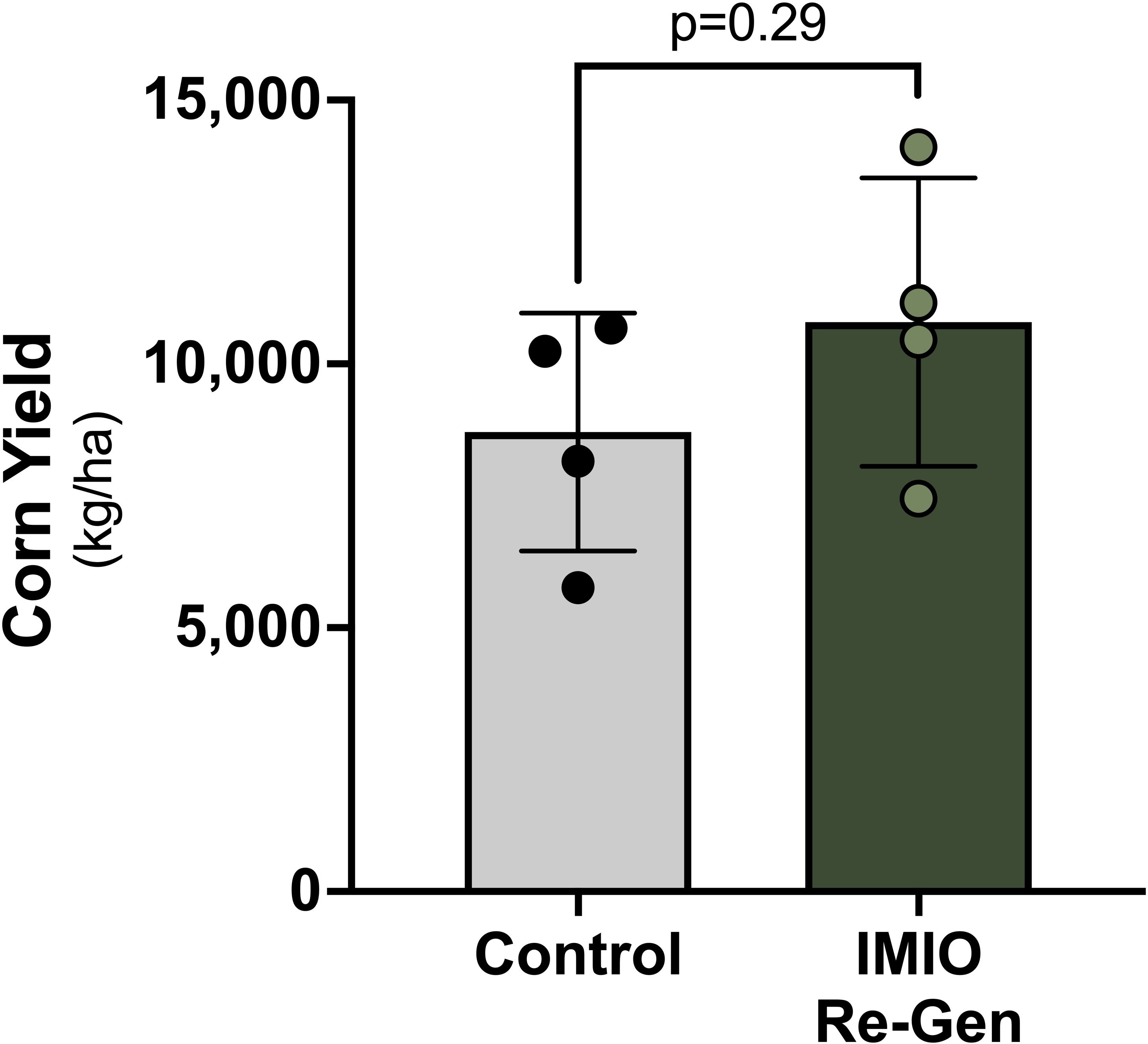
Figure 1 Corn yield in fields treated with Re-Gen increased 24% compared to control-treated fields. VA01, BH01, VA04, and LA05 were treated with control or Re-Gen 2 weeks prior to planting corn. Upon harvesting, plant and ear mass was collected for each treatment in each field. Wet ear mass was converted to bushels/acre using the Wisconsin method for Hand Harvesting Ear Corn, after which it was converted to kg/ha. Each data point per bar represents one biological replicate corresponding to a distinct, paired field. Statistics were calculated using a paired, two-tailed t-test.
In 2023, control treatment in fields LA05 and VA04 resulted in 31.68 and 27.95 metric tons/ha (14.14 and 12.48 tons/acre), respectively (Figure 2). First-time treatment with Re-Gen (“Re-Gen: 1st year”) resulted in 41.19 and 31.43 metric tons/ha (18.29 and 14.03 tons/acre), an increase of 30% and 12.5%, respectively, compared to control fields. Second-time treatment with Re-Gen (“Re-Gen: 2nd year”) resulted in 37.84 and 32.77 metric tons/ha (16.89 and 15.76 tons/acre), an increase of 19% and 17%, respectively, compared to control treatment. The average yield improvement over both fields and seasons was 20%.
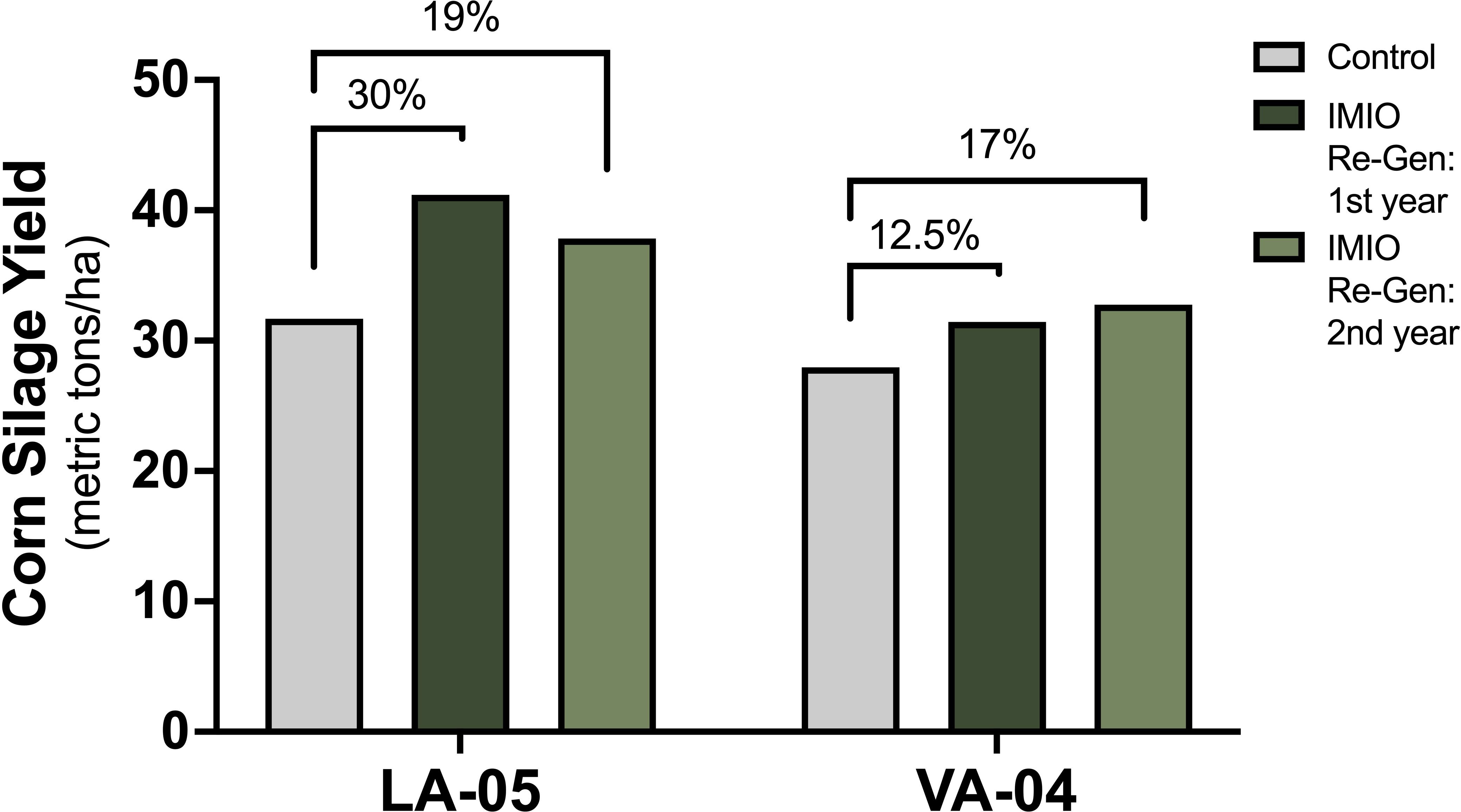
Figure 2 Re-Gen treatment increased corn silage yield compared to control treated fields, an increase seen in consecutive treatment years. LA05 and VA04 were treated with control or Re-Gen 2 weeks prior to planting corn. Upon harvesting, corn silage was collected for each treatment at 3 sites in each field, then pooled to determine yield for the field.
3.2 Soil and plant nutrients
Soil nutrient analysis results, including optimal nutrient levels for corn as provided by Maine Soil Testing Service, are shown in Table 2. Most nutrients are within the optimal levels for corn for each field, however, there are substantial differences between LA05 and VA04 nutrient concentrations, such as in pH, organic matter %, and most notably phosphorus (as phosphate in kg/ha).
Plant tissue nutrient results and sufficiency levels for silking as provided by Cornell University Cooperative Extension are shown in Table 3. Most plant nutrients are within the sufficiency levels for corn for each field, however, there are noteworthy nutrients that were deficient or nearly deficient in the plant tissue for control-treated samples from field VA04 that were increased upon 1st- or 2nd-year Re-Gen treatment: nitrogen, phosphorus, copper, and zinc (Table 3). These results were only seen in field VA04, highlighting the differences in the two fields within the 2023 trial (Table 4).
3.3 Phosphorus bioavailability
Sufficient phosphorus is important for high yield crops, but an excess of phosphorus in the soil can lead to this nutrient moving off-site and causing water quality issues. As noted above, treatment of cover crop residues with Re-Gen for the 1st or 2nd year increased phosphorus bioavailability in the soil (Figure 3A) and in plant tissue (Figure 3B), particularly for field VA04. Re-Gen treated biomass had elevated phosphatase activity at days 7, 16, and 21 compared to the control that was treated with water, indicating that the microbes within Re-Gen are able to produce phosphatases (Figure 4). Phosphatase activity at day 16 was significantly increased in Re-Gen-treated biomass compared to control-treated biomass (p=0.0143). These phosphatases could be partially responsible for the phosphorus results described in Tables 1 and Table 2 and highlighted in Figure 3.
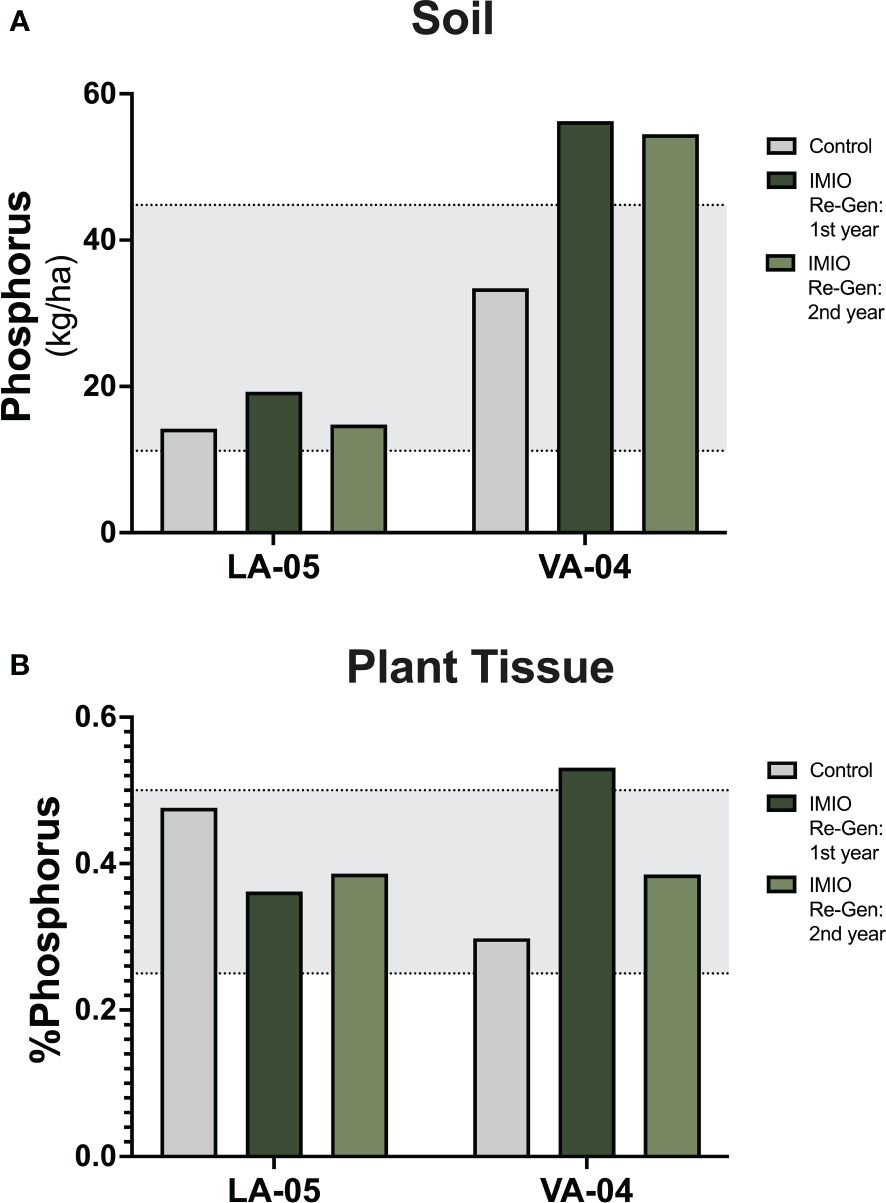
Figure 3 Phosphorus in soil and plant tissue is elevated after Re-Gen treatment in field VA-04. End of season soil samples (A) and silking plant tissue samples (B) were collected from soil and plants in fields LA05 and VA04. Each bar represents one combined representative sample. Gray shading represents optimal and sufficiency levels for soil and plant tissue, respectively.
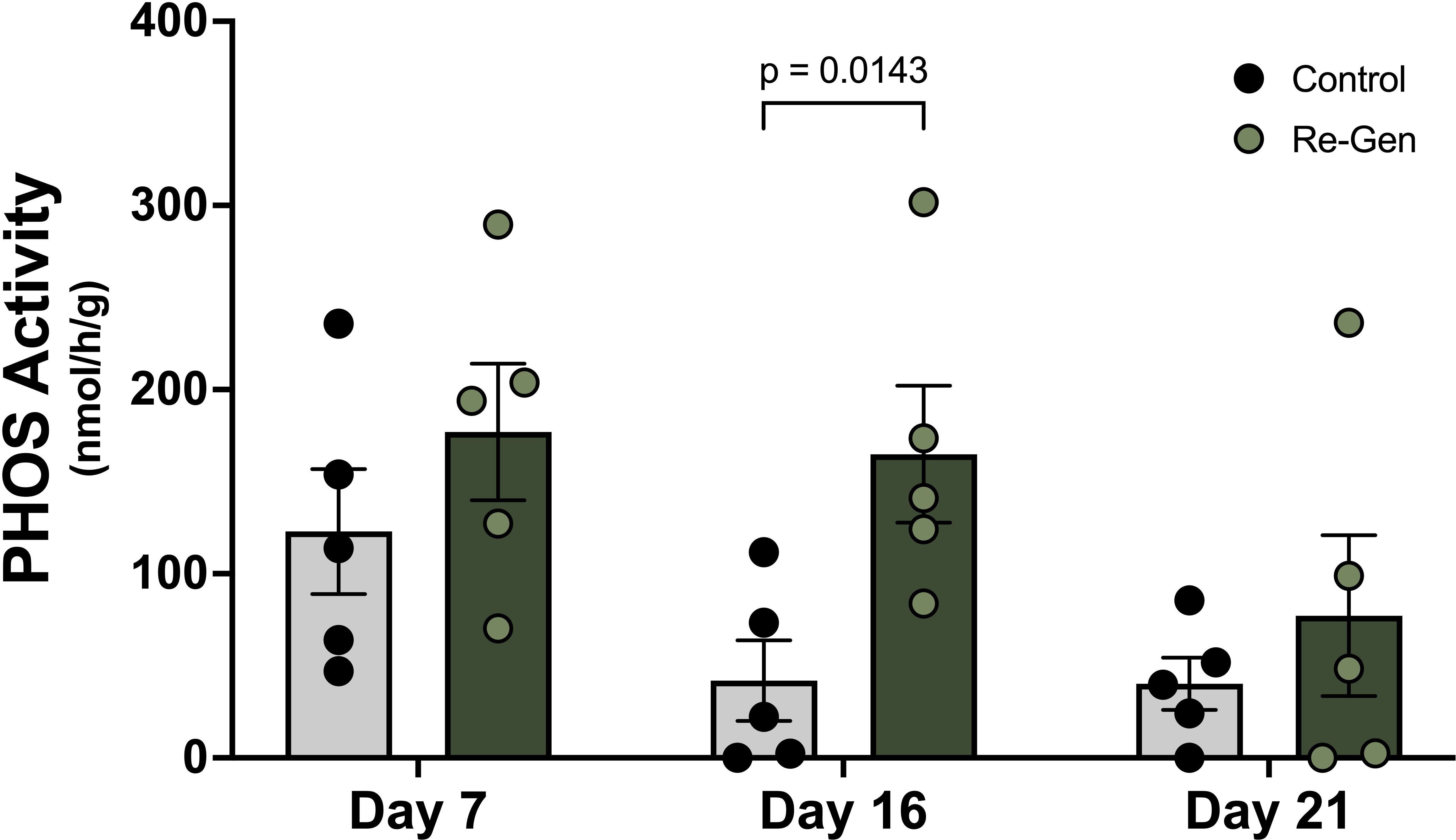
Figure 4 Leftover organic biomass treated with Re-Gen had increased phosphatase activity compared to control-treated biomass. Phosphatase enzyme activity was measured at days 7, 16, and 21 on organic hemp biomass that was recycled with water (control) or Re-Gen. Each data point represents one experimental unit. Each bar represents the mean of 5 replicates, and the error bar is one standard deviation of the mean. A two-way ANOVA was conducted followed by Fisther's post-test. Only statistically significant results are illustrated.
3.4 Economic impact of Re-Gen application
In our 2022 trials, there was a 24% increase in corn yield, equaling a 2083 kg/ha or 33-bushel/acre increase. Considering that the 2022 average price of a bushel of corn was $6.54, this represents a $215.82 increase per acre. With the cost of Re-Gen at $18/acre, this is an 11-fold return on investment based on yield improvement.
These data indicate a potential 24% or 20% increase in total milk yield for corn silage harvested from field LA05 with 1st- or 2nd-year Re-Gen treatment, respectively, compared to control (Figure 5A). There was also a more moderate increase in total milk yield for silage harvested from field VA04 of 9% or 7% upon 1st- or 2nd-year Re-Gen treatment compared to control (Figure 5B). Together, these data indicate the potential for a considerable economic gain when Re-Gen is used to recycle cover crop or corn stover residues in fields prior to planting corn.
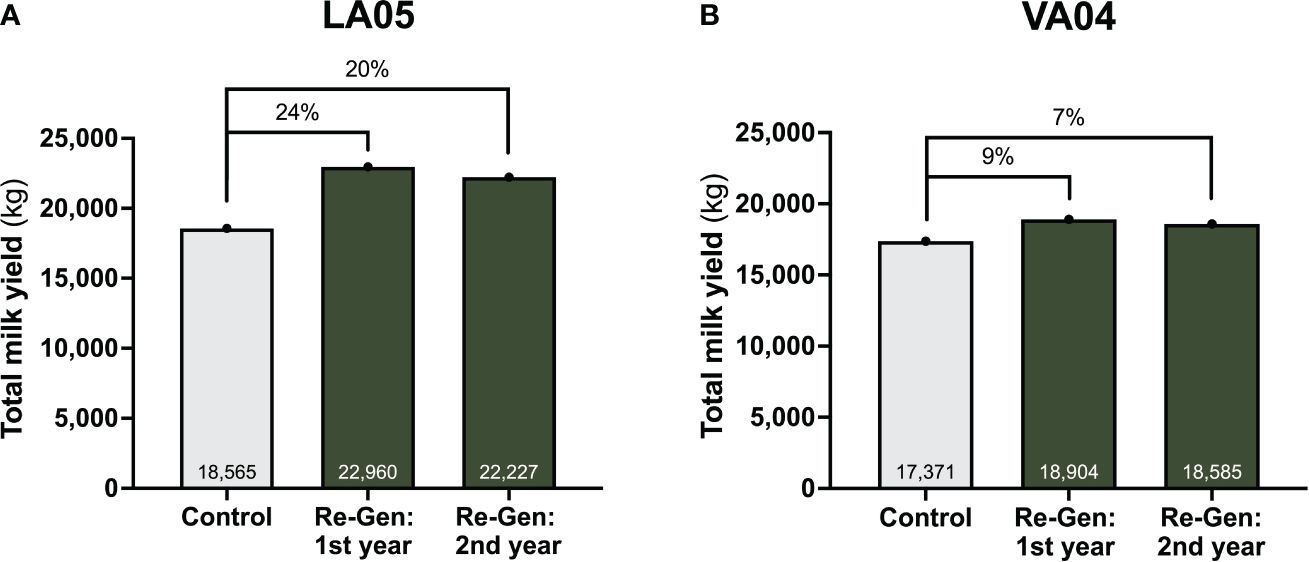
Figure 5 Treatment with Re-Gen can increase the economic value of corn silage as reported by total milk yield (kg). Total milk yield for the 2023 corn silage harvest for LA05 (A) and VA04 (B) was calculated by multiplying the number of milk pounds/ton, as determined by corn silage analysis, by the yields in tons/acre, after which it was converted to kg.
4 Discussion
Our study demonstrated that in-field residue treatment with Re-Gen would increase corn yield and the resultant milk yield from dairy cattle that are fed corn silage grown in Re-Gen treated fields. Yield increases were directly related to increased nutrient bioavailability, as evidenced by soil nutrient analysis as well as plant tissue analysis data. The increased yield may be particularly influenced by increased phosphorus availability, a hypothesis that is supported by an experiment showing elevated phosphatase activity in Re-Gen-treated organic biomass. These effects translate into greater net income for farmers, indicated by an increase in revenue based on bushels/acre in 2022 as well as increased total milk production in 2023.
One pattern evident in the data is the variability in overall productivity between the two fields used in the 2023 trial, LA05 and VA04. Both fields were treated with the same batch of reanimated inoculant and on the same day, eliminating this cause of potential variability. Planting and harvesting dates varied by 2 and 4 days, respectively, potentially contributing to the variability between fields. However, the largest potential cause of variability in the results may be the field characteristics themselves. Although these two fields are both part of the larger Nea Tocht Farm, they are located in different areas on the property and have contrasting soil characteristics. LA05 is a higher elevation field with more sandy soil, whereas the soil in VA04 is variable throughout, but generally is a heavier soil with more clay. Even though these fields have unique characteristics, both fields saw double-digit increases in yield upon Re-Gen treatment when compared to control. However, the pattern of yield increases was different: LA05’s yield increase was larger for 1st year treatment of Re-Gen compared to the 2nd year treatment, whereas VA04 saw a larger yield increase for 2nd year Re-Gen treatment compared to the 1st year treatment. These data could indicate that lighter (sandy, sand-silt-loam) soil texture fields like LA05 could have a large spike in yield from Re-Gen treatment during the first year of Re-Gen implementation that lessens or plateaus with multi-year treatment, whereas heavier (clayey, clay-silt-loam) texture fields may have compounding benefits the longer that Re-Gen is used on the field. Another way the field variability could have impacted the results is the interaction between the soil type with the seed used, SW 3750. SW3750 corn seed is specifically targeted for use in Northern environments and is commonly used in the Northeast (Seedway, 2024). This seed type is preferred in the Northeast in part due to its efficient water utilization, and the extreme flooding that occurred in July 2023 could have impacted growth and yield (Table 1). Although no ponding was recorded in the trial fields throughout the intense rain, it is possible that the different soil profiles combined with the extreme precipitation may explain some of the variation. Heavier fields with clayey textures, like VA04, often hold more water (Gupta and Larson, 1979), and because this seed is characterized by its efficient water utilization, it is possible that too much water had a negative impact on the yield. Additional research is necessary to better understand the benefits of Re-Gen treatment on cover crop residues on different types of fields and over extended multi-year treatments. Additional field trials with Re-Gen are currently underway throughout the Midwestern US and will examine the impact of field variability, geography, and climate on yield improvements associated with Re-Gen use.
Re-Gen treated organic biomass produces more phosphatase enzyme compared to control biomass, which correlates positively with elevated phosphorus in the soil in the 2023 farm trial. Phosphorus has the positive impact of supporting corn growth but can have a negative environmental impact if applied in excess (Stewart et al., 2016). Phosphorus is essential for nearly all stages of corn growth, from root development and early growth to reproductive development of the corn plant (Pereira et al., 2020). Because of its importance, phosphorus is commonly applied at planting to ensure adequate yields at a rate of 89.7 – 134.5 kg/ha (80-120 pounds/acre), depending on geographic location and soil characteristics (LaBarge, 2022). However, excessive application of phosphorus results in dangerous runoff into streams and lakes that results in eutrophication (Conley et al., 2009). Another factor contributing to phosphorus runoff is the presence of non-labile phosphorus, or phosphorus that is unavailable for plant uptake due to a variety of factors including immobilization, adsorption, and soil pH and/or mineralogy (Stewart et al., 2016; Prasad and Chakraborty, 2019). Non-labile phosphorus requires processes like desorption and mineralization of organic matter by soil microbes, including phosphatase processing, for phosphorus to become available for uptake (Prasad and Chakraborty, 2019). Many states, including Vermont, Ohio, and Minnesota, have instituted programs to reduce phosphorus runoff into bodies of water, such as Lake Champlain and the Great Lakes (H2Ohio, 2024; MDA, 2024; NRCS, 2024). If Re-Gen application can increase phosphorus bioavailability in the soil, this could result in additional phosphorus uptake (immobilization) by the plant, potentially preventing phosphorus runoff into nearby lakes and streams, and/or a decreased need for phosphorus to be applied in-field. More work needs to be done to characterize the contribution of Re-Gen recycled biomass and its potential impact on phosphorus uptake and runoff.
While these data are encouraging for Vermont dairy and corn farmers, further trials need to be performed to understand the impact of Re-Gen on farms in the Midwestern United States, where the vast majority of US corn cultivation takes place. These trials, currently underway, will investigate the effectiveness of Re-Gen in the region as well as the feasibility of incorporating Re-Gen into current farming protocols. One concern that will be addressed in these studies is the ability of Re-Gen to be mixed with common herbicides, such as glyphosate. In the Midwestern US, herbicide burndown is a common cover crop termination method, used to mitigate nutrient competition and ensure a release of any scavenged nutrients back to the field (Jewett and Thelen, 2007; Palhano et al., 2018; Adetunji et al., 2020). A widely used commercial herbicide for this strategy is glyphosate (Kumar et al., 2023). While herbicidal desiccation of residual cover crop biomass increases soil nutrient levels (Jewett and Thelen, 2007), the use of glyphosate has also been associated with decreased soil biological activity and microbial diversity (Busse et al., 2001; Nguyen et al., 2016), as well as adverse non-target effects on human and environmental health (Kanissery et al., 2019). Therefore, if a farmer is able to mix Re-Gen with glyphosate-based herbicides, it could help restore the microbial population while increasing nutrient bioavailability following cover crop burndown. Furthermore, the logistical benefit of mixing Re-Gen with glyphosate-based herbicides is that it requires a single pass through the fields rather than two, saving labor and fuel costs. This method of application would keep costs low while restoring the microbial ecosystem and generating additional revenue from the farm’s corn harvest.
As mentioned in the introduction, biostimulants represent a relatively novel and rapidly growing market with the potential to greatly enhance the sustainability of the agricultural industry. However, beneath farmer interest in biostimulants, there is a healthy degree of skepticism, with a recent survey indicating that 45% of farmers either need to know more prior to use or see no benefit in biostimulants, compared to 35% of farmers who see potential in their use (Begeman, 2021). This skepticism largely stems from a variety of factors that need to be addressed prior to their widespread adoption; including, but not limited, to increased manufacturing and safety regulations as well as clear and consistent government policies (reviewed in-depth by (Mannino, 2023)). Additionally, there is a dearth of comprehensive, peer-reviewed/independent research studies describing biostimulants, their effect on yields, and their mechanisms of action that can help farmers make informed purchases (Mannino, 2023). A common approach to evaluating biostimulant performance is through field trials at land-grant universities with agricultural extensions. In 2023, scientists and members of the NCERA-103 committee on non-conventional additives and amendments co-published results from trials examining the five most-common nitrogen-fixing biostimulants: Envita (Azotic, Guelph, Ontario); Utrisha (Corteva Agrisciences, Indianapolis, IN); ProveNⓇ and ProveN40Ⓡ (Pivot Bio, Berkeley, CA); and Micro-AZ-ST (TerraMax, Bloomington, IL) (Franzen et al., 2023). These biostimulants were trialed in 10 states within the North Central region of the US. Of the 61 site-years included in the trials, only 2 corn site-years had positive results with a product alone compared to nitrogen fertilizer alone (Franzen et al., 2023). This study particularly illustrates the understandable skepticism expressed by farmers when considering biostimulant adoption. Another avenue used to independently evaluate products is Beck’s Hybrids Practical Farm Research (PFR)Ⓡ program, an independent, farmer-focused research program that helps farmers find new ways to increase their return on investment (ROI) (Beck’s, 2024). In 2023, Beck’s PFR published results indicating that Micro-AZ-IF Liquid (TerraMax) and Vertex-IF (TerraMax) increased corn yield by 5.6 bushels/acre and 4.6 bushels/acre, respectively, corresponding to an average ROI of $15.61/acre and $10.90/acre, respectively, over 3 years of testing (Kalaher, 2023). Overall, these results highlight the importance of peer-reviewed/independent trials used to evaluate biostimulants. It is essential that biostimulants are investigated in rigorous, peer-reviewed or independent, and multiyear ways to help inform farmer use, determine guidelines for adoption, and ensure farmer success as agriculture moves towards a more sustainable future.
Overall, this study illustrates the potential yield gains made possible by applying the biostimulant Re-Gen to corn stover and cover crop residues, resulting in increased nutrient recycling and bioavailability in corn production. Additionally, this study highlights the potential for biostimulants to increase sustainability within conventional cropping systems while increasing economic value by mitigating the need for excess synthetic nutrients and increasing soil microbial life. More work must be done to develop, investigate, and integrate regenerative practices into agriculture to create a more sustainable, safe, and economically viable agricultural ecosystem.
Data availability statement
The original contributions presented in the study are included in the article/supplementary material. Further inquiries can be directed to the corresponding author.
Author contributions
WG: Writing – original draft, Writing – review & editing, Conceptualization, Data curation, Formal analysis, Investigation, Methodology. AZ: Formal analysis, Writing – original draft, Writing – review & editing. NO: Conceptualization, Investigation, Methodology, Writing – review & editing. DN: Conceptualization, Supervision, Writing – review & editing. CS: Conceptualization, Writing – review & editing, Funding acquisition. VH: Funding acquisition, Supervision, Visualization, Writing – original draft, Writing – review & editing.
Funding
The author(s) declare financial support was received for the research, authorship, and/or publication of this article. Re-Gen development and characterization was funded by NSF SBIR Grant 2014792. The analyses in this study were paid for by IMIO Technologies, Inc.
Acknowledgments
We would like to thank the Vander Wey Family of Nea Tocht Farm for trialing Re-Gen on their fields, applying the product, and sharing their observations during the 2022 and 2023 farm trials.
Conflict of interest
Author WG is the owner of Willie's AGRI-Culture Services, LLC. AZ is an employee of IMIO Technologies, Inc. and holds equity in the company. CS and VH are co-founders of IMIO Technologies, Inc. and hold partial ownership in the company.
The remaining authors declare that the research was conducted in the absence of any commercial or financial relationships that could be construed as a potential conflict of interest.
Publisher’s note
All claims expressed in this article are solely those of the authors and do not necessarily represent those of their affiliated organizations, or those of the publisher, the editors and the reviewers. Any product that may be evaluated in this article, or claim that may be made by its manufacturer, is not guaranteed or endorsed by the publisher.
References
Adetunji A., Ncube B., Mulidzi R., Lewu F. (2020). Management impact and benefit of cover crops on soil quality: A review. Soil Tillage Res. 204. doi: 10.1016/j.still.2020.104717
Albrecht U. (2019). "Plant biostimulants: definition and overview of categories and effects" (UF/IFAS Extension). Available at: https://swfrec.ifas.ufl.edu/docs/pdf/plant-physiology/2019-05-Albrecht-EDIS-H1330.pdf.
Banacos P. (2023) The great Vermont flood of 10-11 July 2023: preliminary meteorological summary (National Weather Service: National Oceanic and Atmospheric Administration). Available online at: https://www.weather.gov/btv/The-Great-Vermont-Flood-of-10-11-July-2023-Preliminary-Meteorological-Summary (Accessed 2024).
Beck’s (2024) Practical farm research (PFR). Available online at: https://www.beckshybrids.com/research/practical-farm-research (Accessed 2024).
Begeman S. (2021) Farmers want proof of concept before trying biologicals (Farm Journal Ag Web). Available online at: https://www.agweb.com/news/crops/corn/farmers-want-proof-concept-trying-biologicals (Accessed 2024).
Braun S. M. (2023). “S.802: plant biostimulant act of 2023”. 118th congress 2022-2023). (Congress.gov). Available at: https://www.congress.gov/bill/118th-congress/senate-bill/802.
Busse M., Ratcliff A., Shestak C., Powers R. (2001). Glyphosate toxicity and the effects of long-term vegetation control on soil microbial communities. Soil Biol. Biochem. 33, 1777–1789. doi: 10.1016/S0038-0717(01)00103-1
CLIMOD Northeast RCC CLIMOD 2. (2024). CIS NOAA Regional Climate Centers. Available at: http://climod2.nrcc.cornell.edu/. [Accessed 2024].
Conley D. J., Paerl H. W., Howarth R. W., Boesch D. F., Seitzinger S. P., Havens K. E., et al. (2009). Controlling eutrophication: nitrogen and phosphorus. Science 323, 1014–1015. doi: 10.1126/science.1167755
Dairy One (2023) Plant tissue analysis. Available online at: https://dairyone.com/services/forage-laboratory-services/plant-tissue-analysis/ (Accessed 2024).
De Andrade L. A., Santos C. H. B., Frezarin E. T., Sales L. R., Rigobelo E. C. (2023). Plant growth-promoting rhizobacteria for sustainable agricultural production. Microorganisms 11, 1–16. doi: 10.3390/microorganisms11041088
DeGaetano A., Moore R., Belcher B., Eck B. (2016) CSF growing degree day calculator (Climate Smart Farming: Cornell University). Available online at: http://climatesmartfarming.org/tools/csf-growing-degree-day-calculator/ (Accessed 2024).
Du Jardin P. (2015). Plant biostimulants: Definition, concept, main categories and regulation. Scientia Hortic. 196, 3–14. doi: 10.1016/j.scienta.2015.09.021
Franzen D., Camberato J., Nafziger E., Kaiser D., Nelson K., Singh G., et al. (2023). "Performance of selected commercially available asymbiotic N-fixing products in the north central region" (North Dakota State University Extension). Available at: https://www.ndsu.edu/agriculture/sites/default/files/2023-04/sf2080.pdf.
Grand A. (2020) Compost: thermophilic compost. Available online at: https://www.best4soil.eu/assets/factsheets/6.pdf.
Gupta S. C., Larson W. E. (1979). Estimating soil water retention characteristics from particle size distribution, organic matter percent, and bulk density. Water Resour. Res. 15, 3. doi: 10.1029/WR015i006p01633
H2Ohio (2024) Enhancing water quality and improving public health. Available online at: https://h2.ohio.gov/ohio-epa/ (Accessed 2024).
Hatfield J., Cruse R., Tomer M. (2013). Convergence of agricultural intensification and climate change in the Midwestern United States: implications for soil and water conservation. Mar. Freshw. Res. 64, 423–435. doi: 10.1071/MF12164
Jewett M., Thelen K. (2007). Winter cereal cover crop removal strategy affects spring soil nitrate levels. J. Sustain. Agric. 29, 55–67. doi: 10.1300/J064v29n03_06
Kalaher C. (2023) Microbial nitrogen fixation in corn (Beck’s). Available online at: https://www.beckshybrids.com/resources/croptalk-newsletter/croptalk-microbial-nitrogen-fixation-in-corn (Accessed 2024).
Kanissery R., Gairhe B., Kadyampakeni D., Batuman O., Alferez F. (2019). Glyphosate: its environmental persistence and impact on crop health and nutrition. Plants (Basel) 8, 1–11. doi: 10.3390/plants8110499
Khangura R., Ferris D., Wagg C., Bowyer J. (2023). Regenerative agriculture - A literature review on the practices and mechanisms used to improve soil health. Sustainability 15, 1–41. doi: 10.3390/su15032338
Kumar A., Chandra R. (2020). Ligninolytic enzymes and its mechanisms for degradation of lignocellulosic waste in environment. Heliyon 6, e03170. doi: 10.1016/j.heliyon.2020.e03170
Kumar V., Singh V., Flessner M. L., Haymaker J., Reiter M. S., Mirsky S. B. (2023). Cover crop termination options and application of remote sensing for evaluating termination efficiency. PloS One 18, e0284529. doi: 10.1371/journal.pone.0284529
LaBarge G. (2022). “Developing phosphorus and potassium recommendations for field crops,” in Agriculture and natural resources (Ohio State University Extension). Available at: https://ohioline.osu.edu/factsheet/agf-0515.
Mannino G. (2023). A new era of sustainability: plant biostimulants. Int. J. Mol. Sci. 24, 1–3. doi: 10.3390/ijms242216329
McIntosh J. (1969). Bray and morgan soil extractants modified for testing acid soils from different parent materials. Agron. J. 61, 259–265. doi: 10.2134/agronj1969.00021962006100020025x
McLennon E., Dari B., Jha G., Sihi D., Kankarla V. (2021). Regenerative agriculture and integrative permaculture for sustainable and technology driven global food production and security. Agron. J. 113, 4541–4559. doi: 10.1002/agj2.20814
MDA (2024) Minnesota agricultural water quality certification program (Minnesota Dfepartment of Agriculture). Available online at: https://www.mda.state.mn.us/environment-sustainability/minnesota-agricultural-water-quality-certification-program (Accessed 2024).
Melkonian J., Poffenbarger H., Mirsky S., Ryan M., Moebius-Clune B. (2017). Estimating nitrogen mineralization from cover crop mixtures using the precision nitrogen management model. Agron. J. 109, 1944–1959. doi: 10.2134/agronj2016.06.0330
Muhie S. (2022). Novel approaches and practices to sustainable agriculture. J. Agric. Food Res. 10, 1–11. doi: 10.1016/j.jafr.2022.100446
Nalley R., Lee C. (2023). “Investigating the nitrogen penalty of cereal cover crops in no-till corn (Zea mays L.),” in ASA CSSA SSSA international annual meeting proceedings. Available at: https://scisoc.confex.com/scisoc/2023am/meetingapp.cgi/Paper/149134.
Neher D., Fang L., Weicht T. R. (2017). Ecoenzymes as indicators of compost to suppress Rhizoctonia solani. Compost Sci. Utilization 25, 251–261. doi: 10.1080/1065657X.2017.1300548
Neher D. A., Weicht T. R., Bates S. T., Leff J. W., Fierer N. (2013). Changes in bacterial and fungal communities across compost recipes, preparation methods, and composting times. PloS One 8, e79512. doi: 10.1371/journal.pone.0079512
Nguyen D., Rose M., Rose T., Morris S., Van Zwieten L. (2016). Impact of glyphosate on soil microbial biomass and respiration: A meta-analysis. Soil Biol. Biochem. 92, 50–57. doi: 10.1016/j.soilbio.2015.09.014
NRCS. (2024). Conservation stewardship program. In: Natural Resources Conservation Service. Available online at: https://www.nrcs.usda.gov/programs-initiatives/csp-conservation-stewardship-program (Accessed 2024).
Olson N., Neher D., Holden V. (2024). On-Farm Conversion of Cannabis sativa Waste Biomass into an Organic Fertilizer by Microbial Digestion. Compost Sci. Utilization, 1–17. doi: 10.1080/1065657X.2023.2296947
Palhano M., Norsworthy J., Barber T. (2018). Evaluation of chemical termination options for cover crops. Weed Technol. 32, 227–235. doi: 10.1017/wet.2017.113
Paravar A., Piri R., Balouchi H., Ma Y. (2023). Microbial seed coating: An attractive tool for sustainable agriculture. Biotechnol. Rep. (Amst) 37, e00781. doi: 10.1016/j.btre.2023.e00781
Perdue S. (2019). “USDA report on plant biostimulants,” in United States Department of Agriculture. (House Committee on Agriculture). Available at: https://agriculture.house.gov/uploadedfiles/usda_report_on_plant_biostimulants_12.20.2019.pdf.
Pereira N., Galindo F., Gazola R., Dupas E., Rosa P., Mortinho E., et al. (2020). Corn yield and phosphorus use efficiency response to phosphorus rates associated with plant growth promoting bacteria. Front. Environ. Sci. 8. doi: 10.3389/fenvs.2020.00040
Potter T. S., Vereecke L., Lankau R. A., Sanford G. R., Silva E. M., Ruark M. D. (2022). Long-term management drives divergence in soil microbial biomass, richness, and composition among upper Midwest, USA cropping systems. Agriculture Ecosyst. Environ. 325, 1–9. doi: 10.1016/j.agee.2021.107718
Prasad R., Chakraborty D. (2019). “Phosphorus basics: understanding phosphorus forms and their cycling in soil,” in Alabama A&M and Auburn Universities Extension. Available at: https://www.aces.edu/wp-content/uploads/2019/04/ANR-2535-Phosphorus-Basics_041719L.pdf.
Raman J., Kim J. S., Choi K. R., Eun H., Yang D., Ko Y. J., et al. (2022). Application of lactic acid bacteria (LAB) in sustainable agriculture: advantages and limitations. Int. J. Mol. Sci. 23, 1–22. doi: 10.3390/ijms23147784
Revillini D., Wilson G. W. T., Miller R. M., Lancione R., Johnson N. C. (2019). Plant diversity and fertilizer management shape the belowground microbiome of native grass bioenergy feedstocks. Front. Plant Sci. 10, 1018. doi: 10.3389/fpls.2019.01018
Russell A. E., Cambardella C. A., Laird D. A., Jaynes D. B., Meek D. W. (2009). Nitrogen fertilizer effects on soil carbon balances in midwestern U.S. agricultural systems. Ecol. Appl. 19, 1102–1113. doi: 10.1890/07-1919.1
Seedway (2024) SW 3750. Available online at: https://www.seedway.com/product/sw-3750/ (Accessed 2024).
Shaver R. (2007). "Evaluating corn silage quality for dairy cattle" (University of Wisconsin Extension). Available at: https://fyi.extension.wisc.edu/forage/evaluating-corn-silage-quality-for-dairy-cattle/.
Sible C. N., Seebauer J. R., Below F. E. (2021). Plant biostimulants: A categorical review, their implications for row crop production, and relation to soil health indicators. Agronomy 11, 1–20. doi: 10.3390/agronomy11071297
Stewart B., Pokhrel P., Bhandari M. (2016). “Positive and negative effects of phosphorus fertilizer on U.S. Agriculture and the environment,” Soil Phosphorus, 1st edition (CRC Press).
USDA (2022). “Impacts and repercussions of price increases on the global fertilizer market,” in International agricultural trade report. (USDA Foreign Agriculture Services). Available at: https://fas.usda.gov/data/impacts-and-repercussions-price-increases-global-fertilizer-market.
USDA (2023). “Crop production,” (Washington, D.C.: Crop Reporting Board, Statistical Reporting Service). Available at: https://downloads.usda.library.cornell.edu/usda-esmis/files/tm70mv177/6395xr873/p2678f18x/crop1023.pdf.
USDA and US Agricultural Statistics Service (2023). "Farm production expenditures: 2022 summary" (Washington, D.C: USDA). Available at: https://www.nass.usda.gov/Publications/Highlights/2023/2022_FarmExpenditures_FINAL_version%202.pdf.
UVM (2022) How to take a soil sample (University of Vermont Extension). Available online at: https://www.uvm.edu/sites/default/files/UVM-Extension-Cultivating-Healthy-Communities/how-to-take-a-soil-sample-2.pdf (Accessed 2024).
Watson D. (2023). "Severe weather and flooding loss & Damage survey results" (Vermont Agency of Agriculture, Food & Markets). Available at: https://agriculture.vermont.gov/sites/agriculture/files/documents/Flood%20Survey%20Results%20Report%202023.pdf.
Keywords: biostimulant, corn, microbial inoculant, nutrient bioavailability, regenerative agriculture, residue management, soil microbiology, sustainability
Citation: Gibson WS, Ziobron AS, Olson NE, Neher DA, Smith CF II and Holden VI (2024) On-farm corn stover and cover crop residue recycling with biostimulant Re-Gen increases corn yields and resultant milk yields in multi-year dairy cattle farm trials. Front. Agron. 6:1420311. doi: 10.3389/fagro.2024.1420311
Received: 19 April 2024; Accepted: 27 May 2024;
Published: 13 June 2024.
Edited by:
Tajamul Hussain, Oregon State University, United StatesReviewed by:
Hafiz Mohkum Hammad, Muhammad Nawaz Shareef University of Agriculture, PakistanAwais Ali, University of Milan, Italy
Copyright © 2024 Gibson, Ziobron, Olson, Neher, Smith and Holden. This is an open-access article distributed under the terms of the Creative Commons Attribution License (CC BY). The use, distribution or reproduction in other forums is permitted, provided the original author(s) and the copyright owner(s) are credited and that the original publication in this journal is cited, in accordance with accepted academic practice. No use, distribution or reproduction is permitted which does not comply with these terms.
*Correspondence: Victoria I. Holden, VmljdG9yaWFAaW1pby5jbw==
 William S. Gibson1
William S. Gibson1 Amy S. Ziobron
Amy S. Ziobron Deborah A. Neher
Deborah A. Neher Victoria I. Holden
Victoria I. Holden